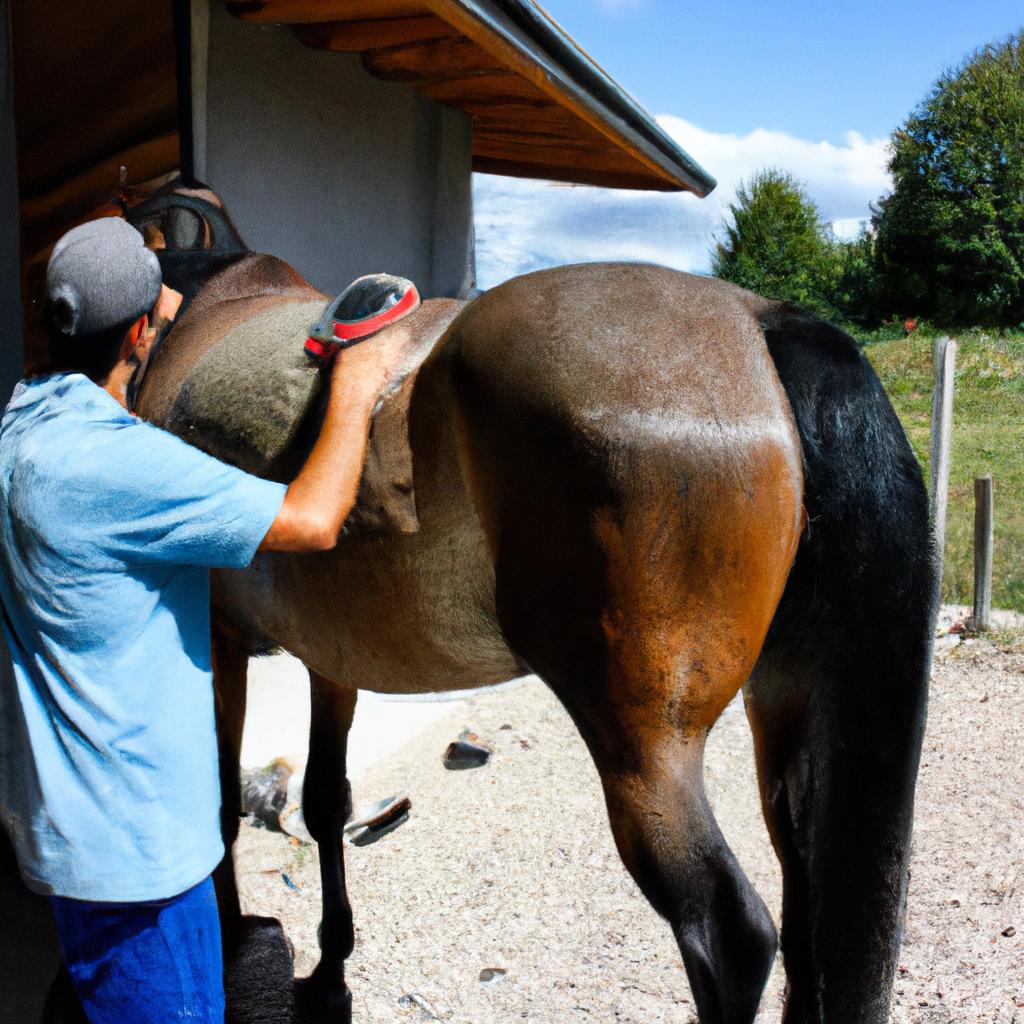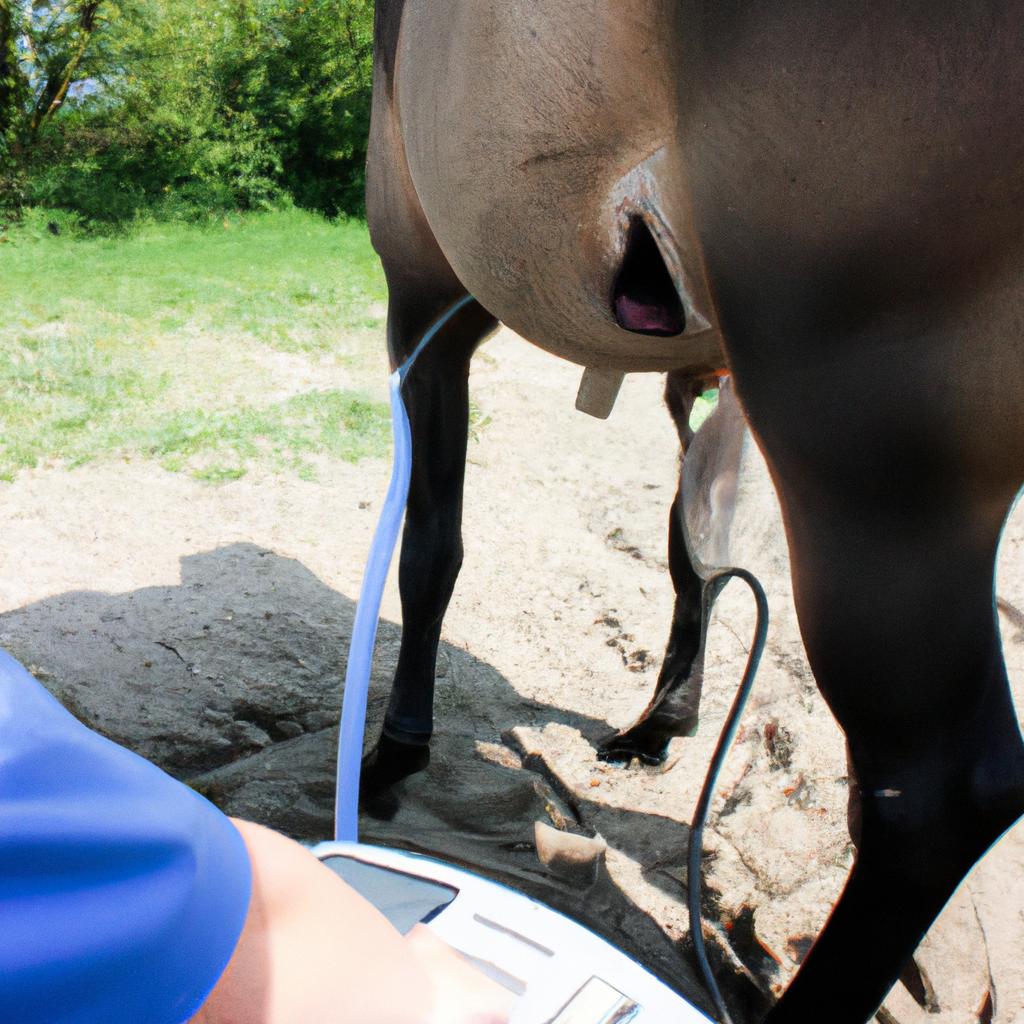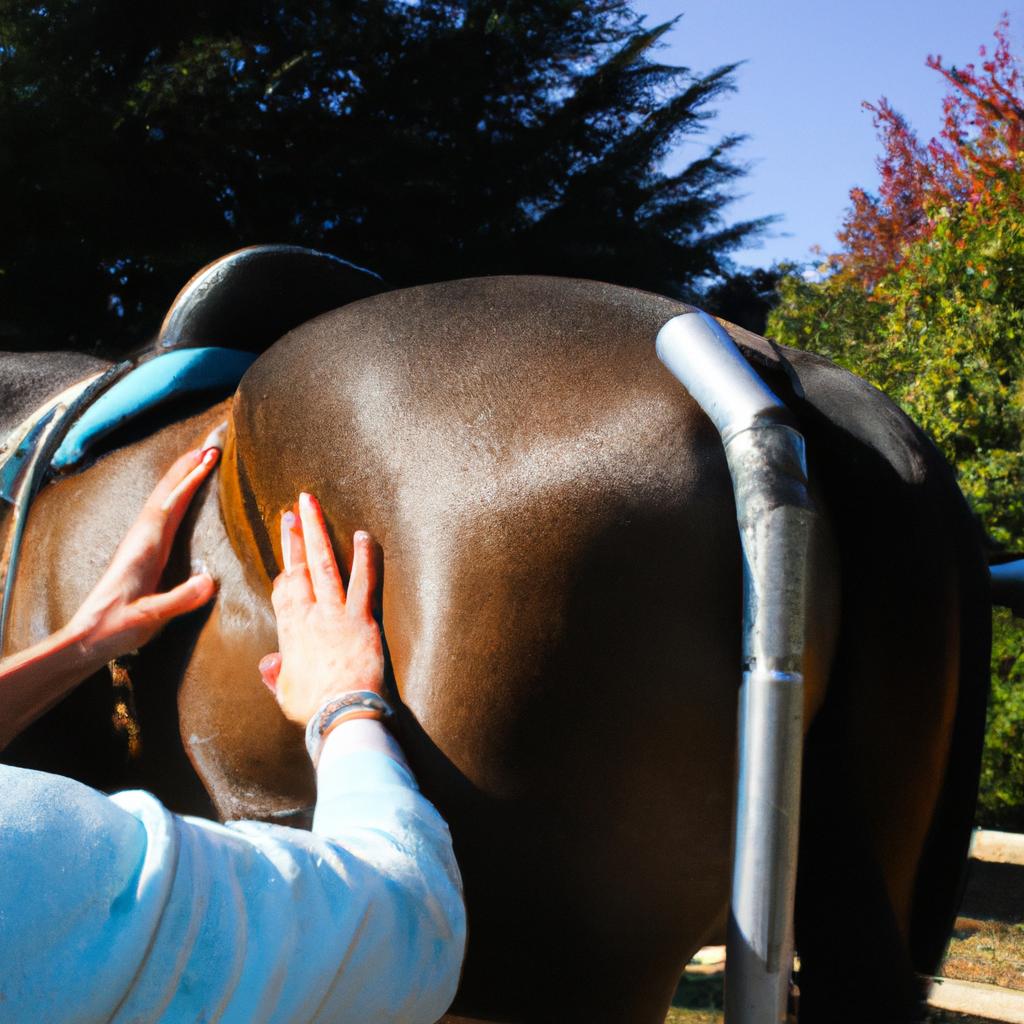Stretching exercises are an essential component of equine chiropractic therapy, contributing to the enhancement of techniques used in this field. The application of stretching exercises aids in improving flexibility, promoting optimal joint function, and increasing range of motion for horses undergoing chiropractic treatment. For instance, consider a hypothetical scenario where a horse named Thunderbolt is experiencing stiffness and limited mobility due to musculoskeletal issues. By incorporating specific stretching exercises as part of his chiropractic sessions, Thunderbolt’s joints can be mobilized effectively, leading to increased comfort and improved athletic performance.
In equine chiropractic care, stretching exercises play a vital role in complementing manual manipulation techniques aimed at aligning the horse’s spine and relieving tension within muscles and connective tissues. These exercises primarily focus on elongating tight muscles while simultaneously strengthening weak areas to restore balance throughout the body. Consequently, they facilitate proper biomechanics by alleviating stress on the skeletal system and promoting efficient movement patterns. This article aims to explore various stretching exercises utilized in equine chiropractic therapy and their benefits in enhancing overall treatment outcomes for horses like Thunderbolt who require intervention to address musculoskeletal imbalances.
Benefits of Stretching for Horses
Benefits of Stretching for Horses
Imagine a scenario where a horse named Bella, who has been experiencing stiffness and limited range of motion in her limbs, undergoes a stretching routine as part of her equine chiropractic treatment. After a few weeks of consistent stretching exercises, Bella’s flexibility improves significantly, allowing her to move more freely while performing various tasks such as jumping or trotting. This example highlights the potential benefits that stretching can provide for horses undergoing chiropractic care.
Stretching exercises offer several advantages when incorporated into an equine chiropractic program. Firstly, they help improve muscle elasticity and joint mobility in horses. By engaging in regular stretches, horses can increase their overall flexibility and reduce the risk of developing musculoskeletal imbalances or injuries. Additionally, stretching enhances blood circulation throughout the body, promoting nutrient delivery and waste removal from tissues. This improved blood flow helps maintain healthy muscles and joints, enabling horses to perform at their optimal level.
- Reduced muscular tension: Regular stretching releases accumulated tension within muscles, preventing discomfort and enhancing relaxation.
- Improved athletic performance: Enhanced flexibility allows horses to execute movements with greater ease and efficiency during training or competition.
- Injury prevention: Stretching helps minimize strain on muscles and tendons by improving their pliability and reducing the likelihood of overstretching or tearing.
- Stress reduction: Engaging in stretching exercises creates a calming effect on horses’ nervous systems, helping alleviate anxiety or restlessness.
Furthermore, incorporating specific types of stretches tailored to address individual needs contributes to optimizing equine chiropractic treatments. The subsequent section will explore different techniques used in equine chiropractic stretching routines without interruption.
By integrating stretching exercises into their daily routines under the guidance of trained professionals, equines like Bella can experience numerous physical benefits that enhance their overall well-being. These improvements include increased flexibility and range of motion, reduced muscular tension, and improved athletic performance. Building upon these advantages, the subsequent section will delve into various types of stretching exercises commonly utilized in equine chiropractic care to further optimize horses’ physical health.
Types of Stretching Exercises for Equine Chiropractic
Stretching exercises play a crucial role in equine chiropractic therapy by enhancing the techniques used to address musculoskeletal issues. To illustrate, let’s consider an example of a horse with limited range of motion in its hindquarters due to muscle tightness. By incorporating specific stretching exercises into the treatment plan, the veterinarian was able to not only increase flexibility and improve joint mobility but also alleviate discomfort for the horse.
To effectively incorporate stretching exercises into equine chiropractic therapy, it is important to understand different types of stretches that can be employed. These stretches are designed to target specific muscles or groups of muscles and promote their elongation, thereby improving overall flexibility and reducing tension. Here are some commonly utilized stretching methods:
- Passive Stretching: In this type of stretch, an external force or assistance is applied to move a joint through its full range of motion. This helps relax tense muscles and increases joint flexibility.
- Active Stretching: Unlike passive stretching, active stretching involves voluntary muscle contractions while moving a joint through its complete range of motion. It aids in strengthening muscles and increasing endurance.
- Dynamic Stretching: This form of stretching involves continuous movement patterns that mimic activities performed during regular exercise or competition. It helps warm up muscles before physical exertion.
- Proprioceptive Neuromuscular Facilitation (PNF): PNF stretching combines alternating contraction and relaxation phases with passive stretches. This technique enhances both static and dynamic flexibility.
Incorporating these various types of stretches allows veterinarians and equine chiropractors to tailor their treatment plans based on individual horse needs. For instance, if a horse shows signs of stiffness in certain areas or has suffered from previous injuries, targeted stretches can help release tension and prevent further complications.
- Improved flexibility leads to increased comfort for the horse
- Reduced muscle tension promotes better overall movement and athletic performance
- Stretching exercises aid in preventing injuries by enhancing joint range of motion
- Regular stretching routines contribute to the horse’s mental well-being, reducing stress levels
Furthermore, a three-column table can be used to provide additional information on specific stretches and their corresponding benefits:
| Stretch Type | Benefits |
|---|---|
| Passive Stretching | Relaxes tense muscles |
| Active Stretching | Strengthens muscles |
| Dynamic Stretching | Warms up muscles before exercise |
| PNF (Proprioceptive Neuromuscular Facilitation) | Increases static and dynamic flexibility |
In summary, incorporating stretching exercises into equine chiropractic therapy offers numerous advantages for horses. Through targeted stretches like passive, active, dynamic, and PNF techniques, veterinarians can improve flexibility, reduce muscle tension, prevent injuries, and enhance overall well-being. By tailoring treatment plans based on individual needs, these stretching exercises play a vital role in optimizing the effectiveness of equine chiropractic care.
Understanding the importance of proper warm-up for stretching is essential to ensure optimal results during equine chiropractic therapy sessions.
Proper Warm-Up for Stretching
Types of Stretching Exercises for Equine Chiropractic: Enhancing Techniques
Imagine a horse named Bella, who has been experiencing stiffness and restricted movement in her hindquarters. Her owner seeks the help of an equine chiropractor to address these issues. In addition to spinal adjustments, the chiropractor incorporates stretching exercises into Bella’s treatment plan to enhance the overall effectiveness of the therapy.
To maximize the benefits of stretching exercises for equine chiropractic, it is important to employ various types of stretches that target different muscle groups. These stretches not only increase flexibility but also promote better range of motion and relieve tension in specific areas. Here are some commonly used stretching techniques:
-
Dynamic Stretches: This type of stretch involves moving joints and muscles through their full range of motion in a controlled manner. By incorporating dynamic stretches such as leg swings or gentle lunges, horses can improve muscle elasticity and warm up their bodies before engaging in more rigorous activities.
-
Static Stretches: Unlike dynamic stretches, static stretches involve holding a particular position for an extended period without any movement. For example, gently pulling back a horse’s leg and holding it at its maximum comfortable extension helps lengthen muscles gradually over time, reducing the risk of strain or injury during exercise.
-
PNF (Proprioceptive Neuromuscular Facilitation) Stretches: PNF stretches combine contraction and relaxation techniques to improve muscular flexibility further. This method typically involves applying resistance against a horse’s limb while they push against it with controlled force. The alternating cycles of contracting and relaxing muscles stimulate neuromuscular pathways, resulting in improved flexibility.
-
Passive Stretches: As the name suggests, passive stretches require minimal effort from the horse being stretched. An external force, such as a handler or equipment like ropes or poles, is utilized to apply gentle pressure on specific body parts while encouraging relaxation and elongation of targeted muscle groups.
To better understand the benefits and effectiveness of these stretching techniques in equine chiropractic, consider the following table:
| Stretching Technique | Benefits |
|---|---|
| Dynamic Stretches | Increases muscle elasticity and prepares the horse for activity. |
| Static Stretches | Gradually lengthens muscles, reducing the risk of strain or injury. |
| PNF Stretches | Enhances neuromuscular pathways, leading to improved flexibility. |
| Passive Stretches | Encourages relaxation and elongation of targeted muscle groups. |
By incorporating a combination of these stretching exercises into an equine chiropractic treatment plan, horses like Bella can experience enhanced results in terms of increased mobility, reduced stiffness, and overall improved musculoskeletal health.
Transitioning into the subsequent section about “Stretching Techniques for Neck and Shoulder,” it is essential to focus on specific areas that commonly require attention during equine chiropractic sessions.
Stretching Techniques for Neck and Shoulder
Section H2: Stretching Techniques for Neck and Shoulder
Having discussed the importance of a proper warm-up in the previous section, let us now delve into stretching techniques specifically tailored for the neck and shoulder. To illustrate their effectiveness, we will explore a hypothetical scenario involving an equestrian athlete named Bella and her horse Max.
Paragraph 1:
Bella, an experienced rider, noticed that Max was displaying signs of stiffness in his neck and shoulders during their training sessions. She decided to incorporate stretching exercises into their routine to alleviate any discomfort he might be experiencing. By adopting these techniques, Bella aimed to enhance Max’s overall flexibility and improve his performance on the field.
- Increased range of motion: Neck and shoulder stretches can help horses achieve a wider range of motion by targeting specific muscles responsible for flexion and extension.
- Improved posture: Regularly practicing these stretches can assist in correcting poor posture caused by muscle imbalances or tightness in the neck and shoulder region.
- Enhanced circulation: Stretching promotes blood flow to the targeted areas, aiding in nutrient delivery and waste removal from nearby tissues.
- Injury prevention: Properly stretched muscles are less prone to strain or injury during rigorous activities such as jumping or sudden changes in direction.
| Stretching Exercise | Technique | Benefits |
|---|---|---|
| Neck lateral flexion | Gently guide the head | – Loosens stiff neck muscles |
| towards each shoulder | – Increases flexibility | |
| – Promotes relaxation | ||
| Shoulder circles | Move forelimbs | – Relieves tension |
| forward then backwards | – Enhances joint mobility | |
| in circular motions | – Encourages better coordination between front limbs | |
| Poll stretch | Apply gentle pressure | – Releases tension in the poll area |
| downward on the horse’s | – Improves flexibility of the neck | |
| forehead | – Relieves tightness and discomfort in the poll region |
Paragraph 2:
In our scenario, Bella began incorporating these stretching techniques gradually into Max’s routine. Through consistent practice, she noticed a significant improvement in his performance. Not only did Max display increased range of motion and improved posture, but he also appeared more relaxed during their training sessions.
By addressing specific areas such as the neck and shoulders, we have laid a strong foundation for enhancing Max’s overall flexibility and well-being. Now, let us explore stretching techniques that target another crucial area – the back and spine.
Stretching Techniques for Back and Spine
Imagine a scenario where an equestrian brings in their horse, Bella, to an equine chiropractor due to stiffness and discomfort in her back. The chiropractor assesses Bella’s condition and determines that incorporating stretching exercises into her treatment plan will help improve flexibility and alleviate the tension in her back muscles.
To effectively stretch the back and spine of horses like Bella, several techniques can be utilized:
-
Passive Stretching: This technique involves gently applying pressure or traction to specific areas of the horse’s back to lengthen and elongate the muscles. It is essential to perform passive stretching with caution, ensuring not to exceed the horse’s comfort level or cause any pain.
-
Active Stretching: In active stretching, the horse actively participates by moving its body through a range of motion under controlled conditions. This technique helps increase muscle strength while also promoting flexibility in the back and spine.
-
Dynamic Mobilization: Dynamic mobilization involves performing rhythmic movements that target specific joints along the horse’s spine. These movements aim to restore joint mobility, reduce stiffness, and enhance overall spinal function.
-
Core Strengthening Exercises: Strengthening the core muscles surrounding the spine plays a crucial role in supporting optimal alignment and stability. Incorporating exercises such as belly lifts or carrot stretches can aid in developing these essential muscle groups.
By implementing these stretching techniques for back and spine regularly, equestrians can effectively enhance their horse’s overall well-being and performance potential. A consistent routine can lead to increased suppleness, improved posture, reduced risk of injury, and enhanced athletic capabilities.
As we move forward towards maintaining a balanced musculoskeletal system for our equine partners, let us now explore various stretching techniques specifically designed for legs and hips – vital components contributing to their agility on both ground work as well as during ridden activities.
Stretching Techniques for Legs and Hips
In the previous section, we discussed stretching techniques specifically targeted towards the back and spine of horses. Now, let us shift our focus to another crucial area that often requires attention in equine chiropractic: the legs and hips. Ensuring proper flexibility and range of motion in these areas is vital for maintaining a horse’s overall well-being and performance.
Imagine a hypothetical scenario where a competitive show jumper named Bella experiences stiffness in her hind legs after participating in intense training sessions. The discomfort hinders her ability to perform at her peak potential, affecting both her confidence and results in competitions. By incorporating targeted stretching exercises into Bella’s routine, equine chiropractors can help alleviate this issue while improving her overall athletic abilities.
To effectively address leg and hip tightness or stiffness, consider implementing the following strategies:
-
Passive Stretching: This technique involves gently manipulating the limbs to extend their range of motion without active participation from the horse. Gradually increasing pressure allows muscles, tendons, and ligaments to relax and elongate, enhancing flexibility.
-
Active Stretching: Unlike passive stretching, active stretching engages the horse by encouraging them to move specific joints through a controlled range of motion on their own. These exercises promote muscle contraction as well as relaxation, helping improve circulation and reduce tension.
-
Targeted Joint Mobilization: Focusing on specific joints such as the fetlock or stifle joint is essential when addressing leg and hip issues. Gentle mobilization techniques applied directly to these areas work towards increasing joint mobility while reducing any accompanying discomfort.
-
Dynamic Flexibility Exercises: Incorporating dynamic stretches into an equine exercise regimen helps warm up muscles before more vigorous activities like jumping or galloping. These exercises involve performing controlled movements that mimic those used during competition or training sessions.
Table: Comparison of Passive vs Active Stretching
| Passive Stretching | Active Stretching | |
|---|---|---|
| Role | Chiropractor or handler applies external pressure | Horse actively moves the joint through its range |
| Benefit 1 | Increases muscle relaxation and elongation | Promotes muscle contraction and relaxation |
| Benefit 2 | Enhances flexibility without active participation | Improves circulation and reduces tension |
By incorporating these stretching techniques into an equine chiropractic routine, professionals can help horses like Bella regain optimal leg and hip mobility. The targeted exercises mentioned above provide a comprehensive approach to addressing stiffness, improving performance, and preventing future injuries. Remember that each horse is unique, so it’s important to tailor the stretching regimen based on individual needs.
Incorporating these stretching techniques into an equine chiropractic routine not only aids in enhancing a horse’s physical abilities but also contributes to their overall well-being. By promoting improved range of motion and flexibility in the legs and hips, practitioners can assist horses in reaching their full potential while minimizing discomfort and maximizing their athletic prowess.
 Eq Muscle Release
Eq Muscle Release



